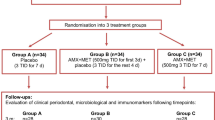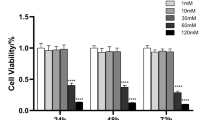Abstract
Background and objective
Peri-implant tissues appear to exhibit a more vigorous inflammatory response during post-operative healing than periodontal tissues. There is evidence that a single dose of amoxicillin (AMX) prior to implant surgery reduces the risk of early peri-implant healing complications. This study compared the effects of AZM and AMX on neutrophil expression of mRNA for mediators involved in peri-implant healing.
Materials and methods
Neutrophils were isolated from healthy human donors and pre-incubated with AZM (4 or 8 μg/ml) or AMX (2 or 4 μg/ml). Cells were then incubated with LPS (1 μg/ml), TNF-α (10 ng/ml), or medium alone (control) for 1, 2, and 4 h. Total RNA was analyzed with qPCR to quantify changes in expression of the six inflammatory mediators.
Results
LPS and TNF-α induced a similar pattern of IL-1β mRNA expression, with peak expression at 1 h. For most mediators, gene expression in neutrophils activated by LPS was markedly reduced in a dose-dependent manner by AZM. Therapeutic concentrations of AZM (8 μg/ml) consistently reduced expression of mediators tested in this study. AMX was effective only in a few cases and under certain conditions. Therefore, AZM was more effective in its direct anti-inflammatory action.
Conclusion
AZM is a consistent and effective inhibitor of neutrophil inflammatory mediator mRNA expression.
Clinical relevance
Given that a single dose of AZM produces higher and more sustained concentrations of this agent in periodontal tissues than AMX when used as a pre-operative prophylactic antibiotic, AZM has greater potential to inhibit inflammatory mediator expression at peri-implant wound sites than AMX.




Similar content being viewed by others
References
Esposito M, Grusovin MG, Willings M, Coulthard P, Worthington HV (2007) The effectiveness of immediate, early, and conventional loading of dental implants: a Cochrane systematic review of randomized controlled clinical trials. Int J Oral Maxillofac Implants 22:893–904
Mayer TM, Hawley CE, Gunsolley JC, Feldman S (2002) The single-tooth implant: a viable alternative for single-tooth replacement. J Periodontol 73:687–693
Duyck J, Naert I (1998) Failure of oral implants: aetiology, symptoms and influencing factors. Clin Oral Investig 2:102–114
Karoussis IK, Bragger U, Salvi GE, Burgin W, Lang NP (2004) Effect of implant design on survival and success rates of titanium oral implants: a 10-year prospective cohort study of the ITI Dental Implant System. Clin Oral Implants Res 15:8–17
Esposito M, Grusovin MG, Worthington HV (2013) Interventions for replacing missing teeth: antibiotics at dental implant placement to prevent complications. Cochrane Database Syst Rev 7:CD004152
Alsaadi G, Quirynen M, Michiles K, Teughels W, Komarek A, van Steenberghe D (2008) Impact of local and systemic factors on the incidence of failures up to abutment connection with modified surface oral implants. J Clin Periodontol 35:51–57
Palma-Carrio C, Maestre-Ferrin L, Penarrocha-Oltra D, Penarrocha-Diago MA, Penarrocha-Diago M (2011) Risk factors associated with early failure of dental implants. A literature review. Med Oral Patol Oral Cir Bucal 16:e514–e517
Esposito M, Thomsen P, Ericson LE, Lekholm U (1999) Histopathologic observations on early oral implant failures. Int J Oral Maxillofac Implants 14:798–810
Emecen-Huja P, Eubank TD, Shapiro V, Yildiz V, Tatakis DN, Leblebicioglu B (2013) Peri-implant versus periodontal wound healing. J Clin Periodontol 40:816–824
Nowzari H, Botero JE, DeGiacomo M, Villacres MC, Rich SK (2008) Microbiology and cytokine levels around healthy dental implants and teeth. Clin Implant Dent Relat Res 10:166–173
Nowzari H, Phamduong S, Botero JE, Villacres MC, Rich SK (2012) The profile of inflammatory cytokines in gingival crevicular fluid around healthy osseointegrated implants. Clin Implant Dent Relat Res 14:546–552
Laskin DM, Dent CD, Morris HF, Ochi S, Olson JW (2000) The influence of preoperative antibiotics on success of endosseous implants at 36 months. Ann Periodontol 5:166–174
Sharaf B, Dodson TB (2011) Does the use of prophylactic antibiotics decrease implant failure? Oral Maxillofac Surg Clin North Am 23(547-550):vi
Wilson W, Taubert KA, Gewitz M et al (2007) Prevention of infective endocarditis: guidelines from the American Heart Association: a guideline from the American Heart Association Rheumatic Fever, Endocarditis, and Kawasaki Disease Committee, Council on Cardiovascular Disease in the Young, and the Council on Clinical Cardiology, Council on Cardiovascular Surgery and Anesthesia, and the Quality of Care and Outcomes Research Interdisciplinary Working Group. Circulation 116:1736–1754
Ho W, Eubank T, Leblebicioglu B, Marsh C, Walters J (2010) Azithromycin decreases crevicular fluid volume and mediator content. J Dent Res 89:831–835
Lai P-C, Schibler MC, Walters JD (2015) Azithromycin enhances phagocytic killing of Aggregatibacter actinomycetemcomitans Y4 by human neutrophils. J Periodontol 86:155–161
Lai P-C, Walters JD (2013) Azithromycin kills invasive Aggregatibacter actinomycetemcomitans in gingival epithelial cells. Antimicrob Agents Chemother 57:1347–1351
Gladue RP, Snider ME (1990) Intracellular accumulation of azithromycin by cultured human fibroblasts. Antimicrob Agents Chemother 34:1056–1060
Jain N, Lai PC, Walters JD (2012) Effect of gingivitis on azithromycin concentrations in gingival crevicular fluid. J Periodontol 83:1122–1128
Escalante MG, Eubank TD, Leblebicioglu B, Walters JD (2015) Comparison of azithromycin and amoxicillin before dental implant placement: an exploratory study of bioavailability and resolution of postoperative inflammation. J Periodontol 86:1190–1200
Kurdowska A, Noble JM, Griffith DE (2001) The effect of azithromycin and clarithromycin on ex vivo interleukin-8 (IL-8) release from whole blood and IL-8 production by human alveolar macrophages. J Antimicrob Chemother 47:867–870
Matsumura Y, Mitani A, Suga T et al (2011) Azithromycin may inhibit interleukin-8 through suppression of Rac1 and a nuclear factor-kappa B pathway in KB cells stimulated with lipopolysaccharide. J Periodontol 82:1623–1631
Shinkai M, Foster GH, Rubin BK (2006) Macrolide antibiotics modulate ERK phosphorylation and IL-8 and GM-CSF production by human bronchial epithelial cells. Am J Physiol Lung Cell Mol Physiol 290:L75–L85
Kikuchi T, Hagiwara K, Honda Y et al (2002) Clarithromycin suppresses lipopolysaccharide-induced interleukin-8 production by human monocytes through AP-1 and NF-kappa B transcription factors. J Antimicrob Chemother 49:745–755
Murphy BS, Sundareshan V, Cory TJ, Hayes D Jr, Anstead MI, Feola DJ (2008) Azithromycin alters macrophage phenotype. J Antimicrob Chemother 61:554–560
Tauber SC, Nau R (2008) Immunomodulatory properties of antibiotics. Curr Mol Pharmacol 1:68–79
Bystrzycka W, Moskalik A, Sieczkowska S, Manda-Handzlik A, Demkow U, Ciepiela O (2016) The effect of clindamycin and amoxicillin on neutrophil extracellular trap (NET) release. Cent Eur J Immunol 41:1–5
Lloyd AR, Oppenheim JJ (1992) Poly’s lament: the neglected role of the polymorphonuclear neutrophil in the afferent limb of the immune response. Immunol Today 13:169–172
Tecchio C, Micheletti A, Cassatella MA (2014) Neutrophil-derived cytokines: facts beyond expression. Front Immunol 5:508. Published 2014 Oct 21. doi:https://doi.org/10.3389/fimmu.2014.00508
Boyum A (1968) Isolation of mononuclear cells and granulocytes from human blood. Isolation of monuclear cells by one centrifugation, and of granulocytes by combining centrifugation and sedimentation at 1 g. Scand J Clin Lab Invest Suppl 97:77–89
Walters J, Lai P-C (2015) Should antibiotics be prescribed to treat chronic periodontitis? Dent Clin N Am 59:919–933
Preshaw PM, Schifferle RE, Walters JD (1999) Porphyromonas gingivalis lipopolysaccharide delays human polymorphonuclear leukocyte apoptosis in vitro. J Periodontal Res 34:197–202
Dovi JV, He LK, DiPietro LA (2003) Accelerated wound closure in neutrophil-depleted mice. J Leukoc Biol 73:448–455
Giamarellos-Bourboulis EJ (2008) Macrolides beyond the conventional antimicrobials: a class of potent immunomodulators. Int J Antimicrob Agents 31:12–20
Desaki M, Takizawa H, Ohtoshi T et al (2000) Erythromycin suppresses nuclear factor-kappaB and activator protein-1 activation in human bronchial epithelial cells. Biochem Biophys Res Commun 267:124–128
Gannon SC, Cantley MD, Haynes DR et al (2013) Azithromycin suppresses human osteoclast formation and activity in vitro. J. Cell. Physiol 28:1098–1107
Bartold PM, du Bios AH, Gannon S et al (2013) Antibacterial and immunomodulatory properties of azithromycin treatment implications for periodontitis. Inflammopharma-cology 21:321–338
Gladue RP, Bright GM, Isaacson RE, Newborg MF (1989) In vitro and in vivo uptake of azithromycin by phagocytic cells: possible mechanism of deliver and release at sites of infection. Antimicrob Agents Chemother 33:277–282
Svanstrom H, Pasternak B, Hviid A (2013) Use of azithromycin and death from cardiovascular causes. N Engl J Med 368:1704–1712
Ray WA, Murray KT, Hall K, Arbogast PG, Stein CM (2012) Azithromycin and the risk of cardiovascular death. N Engl J Med 366:1881–1890
Rao GA, Mann JR, Shoaibi A et al (2014) Azithromycin and levofloxacin use and increased risk of cardiac arrhythmia and death. Ann Fam Med 12:121–127
Acknowledgments
The authors thank Dr. Robert Schifferle (Department of Periodontics and Endodontics, School of Dental Medicine, the State University of New York at Buffalo) for providing purified LPS from Porphyromonas gingivalis.
Funding
This work was supported by an internal grant from the Ohio State University College of Dentistry in Columbus, OH, USA.
Author information
Authors and Affiliations
Corresponding author
Ethics declarations
Conflict of interest
The authors declare that they have no conflict of interest.
Ethical approval
All procedures performed in studies involving human participants were in accordance with the ethical standards of the institutional research committee (reviewed by the Ohio State University Biomedical Sciences Institutional Review Board as study number 2014H0245) and with the 1964 Helsinki declaration and it later amendments or comparable ethical standards.
Informed consent
Informed consent was obtained from all individual participants included in the study.
Additional information
Publisher’s note
Springer Nature remains neutral with regard to jurisdictional claims in published maps and institutional affiliations.
Rights and permissions
About this article
Cite this article
Gibson, M.P., Walters, J.D. Inhibition of neutrophil inflammatory mediator expression by azithromycin. Clin Oral Invest 24, 4493–4500 (2020). https://doi.org/10.1007/s00784-020-03314-4
Received:
Accepted:
Published:
Issue Date:
DOI: https://doi.org/10.1007/s00784-020-03314-4




